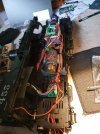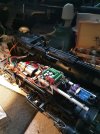DGE-Railroad
The Orchard Line
The Johnson bar is done. I'd hoped to use a linear servo. That thing is tiny! It worked okay but was a bit noisy and the servo motor got pretty hot. I wasn't happy with it so opted for a standard micro servo in the cab
Animated Johnson Bar
I quite enjoy the speed and endpoint setting part of things, it's quite fun!
I've tidied up the loom a bit and run everything back ready for tender connection.
The last job I think is going to be to make a shield for the flywheel. Why its exposed is beyond me, given the amount if wiring around this area. Even with everything strapped down, the slack needed to allow boiler removal means theres some flapping around, to close for comfort

Its surprisingly busy in there!

Animated Johnson Bar
I quite enjoy the speed and endpoint setting part of things, it's quite fun!
I've tidied up the loom a bit and run everything back ready for tender connection.
The last job I think is going to be to make a shield for the flywheel. Why its exposed is beyond me, given the amount if wiring around this area. Even with everything strapped down, the slack needed to allow boiler removal means theres some flapping around, to close for comfort

Its surprisingly busy in there!

